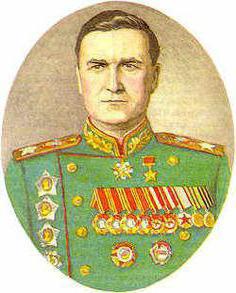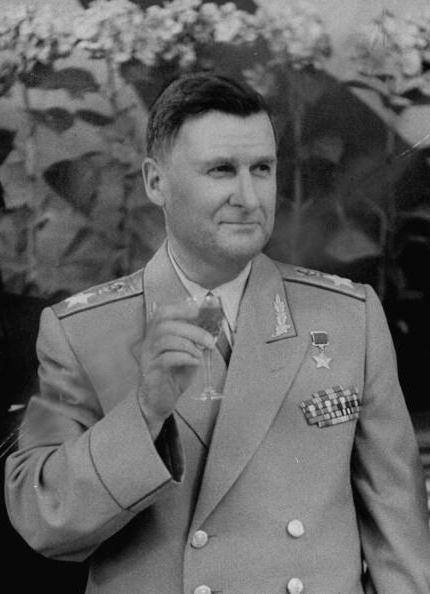Do we remember the names of those brave men who triumphed over fascism for us? The hero of our story is Sokolovsky Vasily Danilovich (1897-1968) - Hero of the Soviet Union. He was one of the leaders of the legendary battle for Moscow. Today, military experts consider him the owner of the true talent of a military leader. He is called a strong-willed, decisive, purposeful and courageous, ready to devote himself entirely to the holy cause of defending the homeland.
Vasily Danilovich Sokolovsky: biography, life story
The future marshal was born in 1897, on July 21, in the small village of Kozlinka, which was located in Białystok county (now located in Poland), in the family of a poor peasant. His childhood, of course, was very difficult, half-starved and cold. However, the boy was quite capable and all the time he was eager to study at a village school. At a more advanced age, wanting to become a teacher, he studied at a special school for two years, and after that he worked as a teacher in a village school. In 1914, he decided to continue his studies at a teacher’s seminary in the city of Nevel (now located in the Pskov region). Here he became involved in the work of the revolutionary circle of students. Times were pre-revolutionary, and members of this organization were monitored by the tsarist secret police. Once during the meeting, they were attacked, and the leader of the group, the Bolshevik Urban, was arrested. All other members, among whom was Sokolovsky Vasily Danilovich, came under investigation. However, the February Revolution put an end to this matter.

Army life
At the beginning of 1918, Vasily Danilovich graduated from the seminary, but after that he did not have to work as a teacher, and the October Revolution broke out. It was at this time that the Worker-Peasant Army began to form in Russia, which later became known as the Red Army. And so V.D.Sokolovsky expressed a desire to join the ranks of this entity. Since he had experience in teaching, he was not accepted into the ranks, but was sent to the First Military Instructor Courses in Moscow, where his studies began to take place at an accelerated pace. As a cadet, he was often attracted to the struggle and liquidation of gangs - opponents of the revolution. Once he had to take part in a battle with the monarchists, which took place at night in a merchant club, and this operation deeply cut into his memory.
Carier start
After graduating from the courses, Sokolovsky was sent to an expeditionary group, which was soon transferred to the Eastern Front, where there was a struggle with the Semenov gang. When approaching Yekaterinburg (at that time the city had not yet been renamed Sverdlovsk), they ran into enemy corps and, having joined the detachment of the Red Guards of the Urals, began to fight with the rebels. For his valor, V. Sokolovsky was appointed commander of a company of scouts, and then received the post of commander of a regiment, part of the 2nd Division, commanded by R. P. Eideman. It was here that he received his first experience of fighting.
Further study
When the Military Academy of the Red Army (then called the Academy of the General Staff) was founded in 1918, the future Marshal Sokolovsky was among the first students. V. Lenin more than once visited this higher educational institution, talked with students. It was here that Vasily Danilovich first saw the Soviet leader, and this meeting made an unforgettable impression on him. Students received theoretical knowledge within the walls of the academy, and then they were sent to study at the front. Sokolovsky was sent to the 10th army, which fought against Denikin, White Cossacks Golubintsev, Mamontov and Shkuro. After that, he returned to Moscow and continued his studies at the academy. A few years later he was assigned to the Caucasus Front. Future Marshal Sokolovsky was appointed chief of staff of the 32nd Infantry Division, which took part in the process of establishing Soviet power in Azerbaijan. They also fought against the Armenian revolutionary party “Dashnaktsutyun”.

Personal life
During the Civil War, the commander met with his wife, Anna Petrovna Bazhenova. Of course, she did not suspect that her husband was the future Marshal Sokolovsky. Anna Petrovna worked in the Staritsin district committee of the RCP (b). She, as her future husband once, joined the ranks of the Red Army voluntarily, worked as an agitator, then commissar of the hospital, and then secretary of the party organizer in Tsaritsino. Then she was transferred to Azerbaijan, to the main headquarters to engage in advocacy work. Here she met with Vasya (as she affectionately called the military commander). After registering the marriage, they went to Moscow, where she began her studies at the Military Economic Academy. However, after graduation, she was unable to return to the army. But V. Sokolovsky was sent to the Turkestan front, where he was most needed. Anna Petrovna went to Tashkent after her husband. However, there, in a foreign land, their little daughter died from the disease, and this was a big blow for the family. But they did not have time to grieve for a long time due to bereavement. Each of them tried to occupy himself completely in order to muffle the pain.
Turkestan
Three years, the couple lived in Central Asia. Soon Sokolvsky was promoted and was appointed commander of a group of troops of the Samarkand and Ferghana regions. During this period, he was wounded by a Basmach bullet, but he did not want to fail. For courage, courage and resourcefulness VD Sokolovsky was awarded the Order of the Red Banner. In 1924, the Turkestan Republic was proclaimed. After that, their family was again transferred to Moscow.
Years of the Second World War
By the beginning of 1942, the future Marshal Sokolovsky was already the head of the headquarters of the Western Front, and a year later he was appointed commander of the front by order of the Supreme Commander, and when the Rzhev-Vyazemsky operation took place in 1943, he was its direct supervisor. It was here that he first fully proved himself and showed everyone what he is capable of. The losses of the Germans were more than 40 thousand people, tanks and other equipment - about 1000. Since mid-1943, the Western Front participated almost simultaneously in two large-scale offensive operations: Orlovskaya, which was otherwise called "Kutuzov" and Smolenskaya, named after the Russian military commander - "Suvorov " In the Smolensk operation, Soviet troops defeated 20 enemy divisions, and 55 were constrained. By the end of this year, the city was completely liberated from the invaders. By the way, during this period, not only Russians, but also French and Polish troops fought under the leadership of Sokolovsky. For services to the fatherland, he was awarded two orders at the end of this operation, and also received the rank of Army General. In the summer of 1946, the mind, valor and courage of Sokolovsky were appreciated and rewarded by the country's leadership. He received the title of hero and Marshal of the USSR.

Personality characteristic
Sokolovsky Vasily Danilovich - Marshal of the Soviet Union - had an outstanding character. He had a powerful analytical mind, he was reasonable and calm, very diplomatic. It is said that when he called to some military unit, he always represented, and only then reported the reason for the call. He was very fond of Russian classics. He loved Pushkin and Tolstoy. Already being a grandfather, he took his granddaughters on an excursion to Yasnaya Polyana and was very worried that the Germans had damaged the estate of his beloved writer. He worked a lot and slept three hours a day. He liked to go mushrooming, but he was not interested in fishing at all. Sokolovsky did not have close friends; nevertheless, he loved communication. He especially liked spending time with his family - his wife, children and grandchildren.
Conclusion
Vasily Sokolovsky, Marshal of the Soviet Union, died at the age of 70. A street in the city of Smolensk is named after him. A memorial plate is installed on one of the houses of the city.